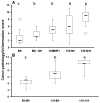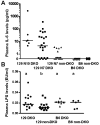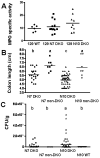Colitis locus on chromosome 2 impacting the severity of early-onset disease in mice deficient in GPX1 and GPX2
- PMID: 20872835
- PMCID: PMC3526817
- DOI: 10.1002/ibd.21479
Colitis locus on chromosome 2 impacting the severity of early-onset disease in mice deficient in GPX1 and GPX2
Abstract
Background: Genetic background has a profound effect on inflammatory bowel disease. The Gpx1 and Gpx2 double knockout (GPX1/2-DKO) mice on a mixed C57BL/6 (B6) and 129S1/SvimJ (129) background exhibit spontaneous ileocolitis. The DKO mice on a B6 background have mild ileocolitis. We characterized the 129 DKO mice to identify a genetic locus affecting disease severity.
Methods: We backcrossed B6;129 DKO mice to 129 and analyzed for ileocolitis penetrance and severity at N5, N7, and N10. By correlating disease severity with single-nucleotide polymorphism (SNP) markers, we identified a colitis locus.
Results: As early as 9 days of age, 129 DKO N5 and N10 mice showed disease signs and morbidity. The N10 DKO mice had the severest colitis with nearly complete penetrance and high morbidity compared with other generations or backgrounds. 129 DKO mice had elevated colonic KC and SAA3 expression, shorter colon length, and cecal E. coli overgrowth compared to B6 DKO mice. Analysis of the B6 loci in 129 N5, N7, and N10 cohorts pointed to a region of chromosome 2: 119 Mbp contributing to mild symptoms.
Conclusions: GPX1/2-DKO mice on 129 genetic background have the most aggressive colitis compared to B6;129 and B6 colonies. A B6 locus significantly contributing the resistance resides on chromosome 2: 119 Mbp. This region coincides with cytokine-deficiency-induced colitis susceptibility, Cdcs3, identified in the resistant B6 and sensitive C3H/HeJBir (C3Bir) with IL-10 deficiency. A three-way SNP analysis between 129, B6, and C3Bir locus points the major candidate genes to B2m, Dnajc17, Duox2, Pla2g4b, Pla2g4e, Pla2g4f and Slc30a4.
Copyright © 2010 Crohn's & Colitis Foundation of America, Inc.
Figures









Similar articles
-
Analysis of candidate colitis genes in the Gdac1 locus of mice deficient in glutathione peroxidase-1 and -2.PLoS One. 2012;7(9):e44262. doi: 10.1371/journal.pone.0044262. Epub 2012 Sep 6. PLoS One. 2012. PMID: 22970191 Free PMC article.
-
Mutation accumulation in the intestine and colon of mice deficient in two intracellular glutathione peroxidases.Cancer Res. 2006 Oct 15;66(20):9845-51. doi: 10.1158/0008-5472.CAN-06-0732. Cancer Res. 2006. PMID: 17047045
-
The Gdac1 locus modifies spontaneous and Salmonella-induced colitis in mice deficient in either Gpx2 or Gpx1 gene.Free Radic Biol Med. 2013 Dec;65:1273-1283. doi: 10.1016/j.freeradbiomed.2013.09.013. Epub 2013 Oct 1. Free Radic Biol Med. 2013. PMID: 24090658 Free PMC article.
-
The beginning of GPX2 and 30 years later.Free Radic Biol Med. 2022 Aug 1;188:419-433. doi: 10.1016/j.freeradbiomed.2022.06.232. Epub 2022 Jul 5. Free Radic Biol Med. 2022. PMID: 35803440 Free PMC article. Review.
-
Expression and chromosomal mapping of mouse Gpx2 gene encoding the gastrointestinal form of glutathione peroxidase, GPX-GI.Biomed Environ Sci. 1997 Sep;10(2-3):156-62. Biomed Environ Sci. 1997. PMID: 9315306 Review.
Cited by
-
Selenium and inflammatory bowel disease.Am J Physiol Gastrointest Liver Physiol. 2015 Jul 15;309(2):G71-7. doi: 10.1152/ajpgi.00379.2014. Epub 2015 Jun 4. Am J Physiol Gastrointest Liver Physiol. 2015. PMID: 26045617 Free PMC article. Review.
-
Analysis of candidate colitis genes in the Gdac1 locus of mice deficient in glutathione peroxidase-1 and -2.PLoS One. 2012;7(9):e44262. doi: 10.1371/journal.pone.0044262. Epub 2012 Sep 6. PLoS One. 2012. PMID: 22970191 Free PMC article.
-
Nox1 causes ileocolitis in mice deficient in glutathione peroxidase-1 and -2.Free Radic Biol Med. 2014 Mar;68:315-25. doi: 10.1016/j.freeradbiomed.2013.12.018. Epub 2013 Dec 25. Free Radic Biol Med. 2014. PMID: 24374371 Free PMC article.
-
Colitis-associated colon cancer: Is it in your genes?World J Gastroenterol. 2015 Nov 7;21(41):11688-99. doi: 10.3748/wjg.v21.i41.11688. World J Gastroenterol. 2015. PMID: 26556996 Free PMC article. Review.
-
Expression of lactoperoxidase in differentiated mouse colon epithelial cells.Free Radic Biol Med. 2012 May 1;52(9):1569-76. doi: 10.1016/j.freeradbiomed.2012.02.009. Epub 2012 Feb 15. Free Radic Biol Med. 2012. PMID: 22343415 Free PMC article.
References
-
- Neish AS, Gewirtz AT, Zeng H, et al. Prokaryotic regulation of epithelial responses by inhibition of IkappaB-alpha ubiquitination. Science. 2000;289:1560–1563. - PubMed
-
- Esworthy RS, Aranda R, Martin MG, et al. Mice with combined disruption of Gpx1 and Gpx2 genes have colitis. Am J Physiol Gastrointest Liver Physiol. 2001;281:G848–855. - PubMed
-
- Esworthy RS, Swiderek KM, Ho YS, et al. Selenium-dependent glutathione peroxidase-GI is a major glutathione peroxidase activity in the mucosal epithelium of rodent intestine. Biochim Biophys Acta. 1998;1381:213–226. - PubMed
Publication types
MeSH terms
Substances
Grants and funding
LinkOut - more resources
Full Text Sources
Medical
Molecular Biology Databases
Research Materials
Miscellaneous
